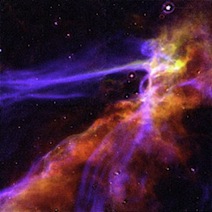Enceladus, one of Saturn’s moons, is covered with water ice. Could there be a liquid ocean beneath the icy crust? As announced at a meeting of NASA’s Enceladus Focus Group at the SETI Institute in Mountain View, California, there seems to be more and more evidence supporting that idea.
In 2005, the Cassini spacecraft discovered water-rich plumes venting from Enceladus’ south polar region, when performing close flybys of Saturn’s moon. These jets, composed mainly of water vapor, could be fed by an underground liquid ocean, scientists hope. There are also other possible explanations, which do not involve liquid water at all.

However, recent findings seem to back the hypothesis of a liquid water ocean beneath the frozen surface of Enceladus. First, the amounts of ice and gas in the plumes are very similar: such proportions would be difficult to observe in the absence of liquid water. Second, the chemistry of the materials inside the plumes also points to liquid water. Saturn’s E-ring, in which Enceladus is orbiting the gas giant, is rich in sodium. Enceladus is suspected to be the main source of particles for that ring: if the ice crystals were originally vapor which later re-condensed to ice, there would not be any sodium. Cassini also found traces of compounds such as carbonates and dust grains, strengthening evidence that there is an ocean under the frozen surface.
On the other hand, Cassini also revealed the presence of some compounds that is inconsistent with liquid water. Hydrogen cyanide, for example, reacts with liquid water to form other compounds: hydrogen cyanide has been found in the plumes, but not the compounds resulting from its interaction with water. A possible explanation would be that the plumes are fed by a variety of simultaneous processes.

Another interesting finding indicates that the plumes might have been active for a very long time. So far, it was thought they had been active for a few hundred years, enough to form Saturn’s E ring. Because of the thickness of the layer of ice crystals and the rate at which they fall back to the moon’s surface, new estimates suggest the plumes could have been active for tens of millions of years.
Radioactive decay and tidal flexing from Saturn’s gravitational pull cannot account for the necessary energy to drive the plumes: the origin of this energy remains unknown. This suggests that the plumes are not a continuous phenomenon, but rather something sporadic.
Finally, the most important and exciting question is to know whether Enceladus produces enough heat to harbor a liquid-water ocean beneath its icy surface. Although it seems very unlikely that Enceladus could maintain a global ocean, it is not impossible that a smaller, regional ocean might exist. If any is found to exist, this would make Enceladus a good candidate for the harboring of extraterrestrial life.

